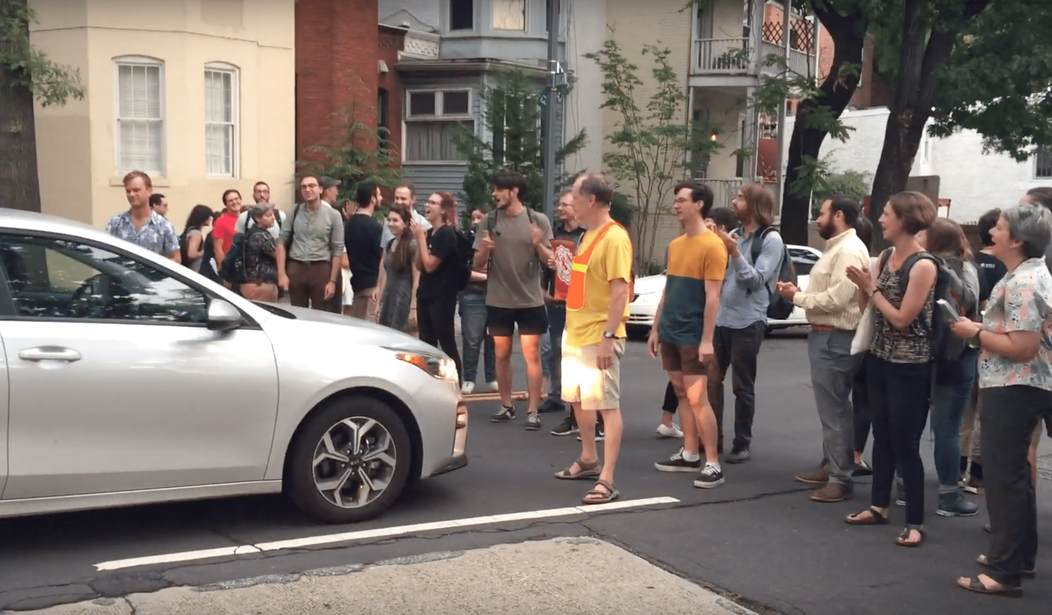On Wednesday, climate change activists gathered to block traffic in Washington, D.C. This mini protest offered a small taste of what the group “Shut Down DC” plans to do on September 23 — strangle traffic in the streets of the nation’s capitol to prevent “business as usual.”
“The earth is on fire! Put the fire out!” protesters chanted as they chocked off traffic on Florida Avenue NW between R and S Streets. Drivers honked, glared, and shouted along the lines of ‘f**king move or I’ll smack the sh*t out of you,” the Washingtonian reported.
After about five minutes, the protesters gave up and returned to their planning meeting.
“On September 23rd, we are going to shut down DC,” the group’s website announces. “We will block key infrastructure to stop business-as-usual, bringing the whole city to a gridlocked standstill. Parents, workers, college students, and everyone who is concerned about the climate crisis will skip work and school and put off their other responsibilities to take action on the climate crisis.”
In other words, the protesters are so sure that the world faces climate Armageddon that they are willing to shut down America’s capital city. But the protesters are more likely to annoy D.C. residents than convince them.
Other protesters have tried to shut down the nation’s capital. An action in May 1971 led to the largest mass arrest in U.S. history after authorities acquired the group’s detailed tactical manual, sending police forces to key sites in advance.
Shut Down DC organizer Patrick Young cited that protest as an inspiration. He said Shut Down DC aims to avoid that mistake by decentralizing the organization, breaking the protest into 24 “affinity groups” operating under the broader “Shut Down DC” umbrella.
“We don’t need to have somebody who’s in charge if we can all take responsibility for what we’re doing and if we can all communicate with each other about what’s happening,” Young told the Washingtonian. That way, “everybody is able to take leadership.”
Yet this plan also fosters confusion. For example, the group has an official policy that emergency vehicles and drivers in an emergency should be allowed through the protest lines. Yet that message did not reach the protesters involved in Wednesday’s trial run. One man exited his car to tell a protester that he was trying to visit his wife in the hospital. The protester just kept smiling and chanting.
“F**k all of you,” yelled the driver as he got back into his car. ‘I hope you all have husbands and wives and I hope they get sick and you can’t visit them,” he said, honking repeatedly at the protesters.
Shut Down DC said its blockades will be strategically placed to impact the most powerful in the capital: intersections near places of money or power. The group said it plans to avoid blocking public transportation.
While only 424 people “like” the Shut Down DC Facebook page, about 2,000 have expressed interest in the September 23 protest. It seems unlikely these people will shut down the nation’s capital, but they might make life more difficult for everyone in the region. It will also not be possible to frustrate only Trump administration officials or corporate lobbyists. All sorts of commuters will get caught in the scuffle, and D.C. residents may develop a grudge for the activists who think their cause is more important than locals’ everyday lives.
It seems important to note that despite ever-rising levels of climate alarmism, the science on climate change is far from settled. The much-touted “97 percent consensus” statistic is based on an extremely misleading study that proves nothing of the sort. Alarmist predictions have proved false again and again, and the Maldives islands — which were supposed to shrink beneath the waves by 2018 — remain resolutely above sea level, and are even growing.
But good job, alarmists! The residents of Washington, D.C. can never agree on anything, but in two weeks both Republicans and Democrats are likely to be more than a little frustrated at these climate change protesters who think they should run America’s capital.
Follow Tyler O’Neil, the author of this article, on Twitter at @Tyler2ONeil.









Join the conversation as a VIP Member